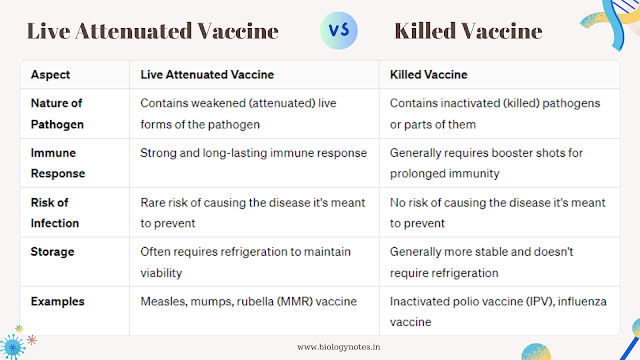Difference between Live attenuated and Killed vaccine:
A live attenuated vaccine is a type of vaccine made from a weakened form of the virus or bacteria that causes the disease. These vaccines are designed to replicate in the body, stimulating a strong immune response without causing illness. Three examples of live, attenuated vaccines: Measles, Mumps, and Rubella (MMR) vaccine, Oral polio vaccine (OPV), and chickenpox vaccine.
Killed vaccines, also called inactivated vaccines, are created by rendering the disease-causing viruses or bacteria non-infectious through methods like heat, chemicals, or radiation. Unlike live vaccines, killed vaccines do not replicate within the body. Instead, they introduce the body to pieces of the dead pathogens, triggering an immune response.
Read: 5 Difference between red muscle and white muscle fibers
Read: 5 Important difference between Tendon and Ligaments
Difference between Live attenuated and Killed vaccines in Tubular Form:
| Live Attenuated Vaccine | Killed Vaccines |
|---|---|
| Attenuated Vaccines are also known as live vaccines. | Inactivated Vaccines are also known as dead vaccines. |
| Live, attenuated vaccines contain living pathogens. | Inactivated vaccines contain a killed version of the pathogen. |
| A live attenuated vaccine is a live vaccine made by reducing the virulence of the virus by some methods. | An inactivated/Killed vaccine is a vaccine made of a dead virus, which has the ability to stimulate immunity. |
| The live attenuated vaccine is not easy to transport and preserve because it is a live vaccine. | An inactivated vaccine is relatively easy to transport and preserve because it is a dead vaccine. |
| A single dose of vaccine is sufficient to boost immunity. | Multiple doses are required to boost immunity. |
| Live vaccines produce long-term immunity. | Killed vaccines produce short-term immunity. |
| Examples of live vaccines are Measles, mumps, and chicken pox vaccines, etc. | Examples of inactivated vaccines are hepatitis A, inactivated poliovirus (IPV) vaccine, whooping cough vaccine, rabies vaccine, etc. |
